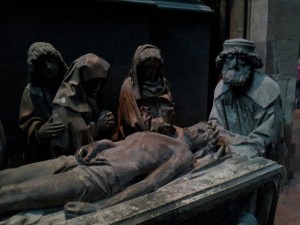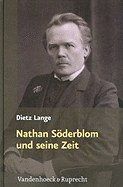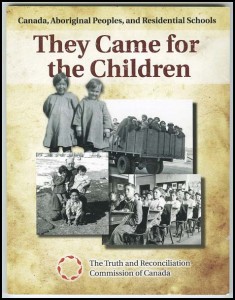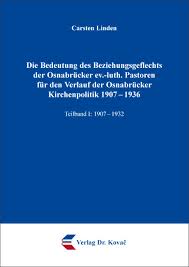Contemporary Church History Quarterly
Volume 19, Number 3 (September 2013)
Research Note: New Works on German Roman Catholicism Published within 2012-2013
By Kevin P. Spicer, C.S.C., Stonehill College
Keeping up with the ever-expanding literature on recent German church history remains a daunting challenge. We hope this list of newer publications on the Roman Catholic Church in Germany serves to aid CCHQ readers who research or teach in this area.
Anderson, Margaret Lavinia. “Anatomy of an Election: Anti-Catholicism, Antisemitism, and Social Conflict in the Era of Reichsgründung and Kulturkampf.” In Von Freiheit, Solidarität und Subsidiarität – Staat und Gesellschaft der Moderne in Theorie und Praxis. Festschrift für Karsten Ruppert zum 65. Geburtstag. Edited by Markus Raasch and Tobias Hirschmüller. Berlin: Duncker & Humblot, 2013: 39-95.
Bankier, David, Dan Michman, and Iael Nidam-Orvieto, eds. Pius XII and the Holocaust: Current State of Research. Jerusalem: Yad Vashem, 2012.
Bennette, Rebecca Ayako. Fighting for the Soul of Germany: The Catholic Struggle for Inclusion after Unification. Cambridge, MA: Harvard University Press, 2012.
Bergen, Doris L. “Speak of the Devil: Hubert Wolf on Pope Pius XI and the Vatican Archives” (Review Essay). Harvard Theological Review 105 (2012): 115-121.
Beschet, Paul, SJ. Mission in Thuringia in the Time of Nazism. Translated by Theodore P. Fraser. Milwaukee, WI: Marquette University Press, 2012.
Burkard, Dominik. Johannes Baptista Sproll: Bischof im Widerstand. Stuttgart: Kohlhammer, 2013.
Cieslak, Stanislaw. “Auf der Suche nach Versöhnung. Kardinal Adam Kozlowieckis Erinnerungen an seine Zeit im KZ Dachau.” Stimmen der Zeit 230 (2012): 397-408.
Connelly, John. From Enemy to Brother: The Revolution in Catholic Teaching on the Jews 1933-1965. Cambridge, MA: Harvard University Press, 2012.
Coppa, Frank J. The Life & Pontificate of Pope Pius XII. Between History & Controversy. Washington, DC: The Catholic University of America Press, 2013.
Dahlke, Benjamin. “Zwischen Gegnerschaft und Kollaboration. Zur Geschichte der Philosoph-Theologischen Akademie Paderborn während des Nationalsozialismus.” Jahrbuch für mitteldeutsche Kirchen- und Ordensgeschichte 8 (2012): 49-82.
Deschner, Karlheinz. Mit Gott und den Faschisten: Der Vatikan im Bunde mit Mussolini, Franco, Hitler und Pavelic. Reprint (new press). Freiburg: Ahriman, 2012.
Ehret, Ulrike. Church, Nation and Race: Catholics and Antisemitism in Germany and England, 1918-45. Manchester: Manchester University Press, 2012.
Eisner, Peter. The Pope’s Last Crusade: How and American Jesuit Helped Pope Pius XI’s Campaign to Stop Hitler. NY: William Morrow, 2013.
Ericksen, Robert P. Complicity in the Holocaust. Churches and Universities in Nazi Germany. Cambridge: Cambridge University Press, 2012.
Feldmann, Christian. Einen Eid auf Hitler? Nie. Franz Reinisch: Ein Leben für die Menschenwürde. Vallendar: Patris, 2012.
Fibich, Jan Kanty. Die Caritas im Bistum Limburg in der Zeit des „Dritten Reiches“ (1929-1946). Mainz: Gesellschaft für Mittelrheinische Kirchengeschichte, 2012.
Flammer, Thomas. Nationalsozialismus und katholische Kirche im Freistaat Braunschweig 1931-1945. Paderborn: Ferdinand Schöningh, 2013.
Gerber, Stefan. “Vom Barnabasbrief zum ‘Mythus des 20. Jahrhunderts’: Philipp Haeuser (1876-1960).” In Von Freiheit, Solidarität und Subsidiarität – Staat und Gesellschaft der Moderne in Theorie und Praxis. Festschrift für Karsten Ruppert zum 65. Geburtstag. Edited by Markus Raasch and Tobias Hirschmüller. Berlin: Duncker & Humblot, 2013: 427-448.
Goldstein, Phyllis. A Convenient Hatred: The History of Antisemitism. Brookline, MA: Facing History and Ourselves, 2012.
Helbach, Ulrich, ed. Akten deutscher Bischöfe seit 1945. Westliche Besatzungszonen 1945-1947. 2 Volumes. Paderborn: Ferdinand Schöningh, 2012.
Hesemann, Michael. Hitlers Religion. Reprint (new press). Augsburg: Sankt Ulrich, 2012.
Holzbauer, Matthias. Der unselige Papst. Pius XII. und seine Verstrickung in die Verbrechen des 20. Jahrhunderts … und weshalb der Vatikan ihn seligsprechen will. Marktheidenfeld: Das Weisse Pferd, 2012.
Houlihan, Patrick J. “Local Catholicism as Transnational War Experience: Everyday Religious Practice in Occupied Northern France, 1914-1918.” Central European History 45 (2012): 233-267.
Hürten, Heinz. “50 Jahre Kommission für Zeitgeschichte: Überlegungen zu Problemen der Katholizismusforschung.” In Von Freiheit, Solidarität und Subsidiarität – Staat und Gesellschaft der Moderne in Theorie und Praxis. Festschrift für Karsten Ruppert zum 65. Geburtstag. Edited by Markus Raasch and Tobias Hirschmüller. Berlin: Duncker & Humblot, 2013: 753-760.
Käßmann, Margot, ed. Gott will Taten sehen. Christlicher Widerstand gegen Hitler. Ein Lesebuch. Munich: C. H. Beck, 2013. Kidder, Annemarie S., ed. Ultimate Price: Testimonies of Christian who Resisted the Third Reich. Maryknoll, NY: Orbis Books, 2012.
Kitzmüller, Stefan. “Der österreichische Franziskaner P. Zyrill Fischer (1892-1945). Früher Widerstand gegen den Nationalsozialismus.” Wissenschaft und Weisheit. 75 (2012): 80-101.
Lapomarda, Vincent A. The Catholic Bishops of Europe and the Nazi Persections of Catholics and Jews. Lewiston, NY: The Edwin Mellon Press, 2012.
Lawler, Justus George. Were the Popes Against the Jews? Tracking the Myths, Confronting the Ideologues. Grand Rapids, MI: William M. Eerdmans, 2012.
Legge, Jerome S., Jr. “Resisting a War Crimes Trial: The Malmedy Massacre, the German Churches, and the U.S. Army Counterintelligence Corps.” Holocaust and Genocide Studies 26 (2012): 229-260.
Loth, Wilfried. “Der Katholizismus und die Durchsetzung der modernen Demokratie.” In Von Freiheit, Solidarität und Subsidiarität – Staat und Gesellschaft der Moderne in Theorie und Praxis. Festschrift für Karsten Ruppert zum 65. Geburtstag. Edited by Markus Raasch and Tobias Hirschmüller. Berlin: Duncker & Humblot, 2013: 737-751.
Malak, Henryk Maria. Shavelings in Death Camps. A Polish Priest’s Memoir of Imprisonment by the Nazis, 1939-1945. Translated by Bozenna J. Tucker and Thomas R. Tucker. Jefferson, NC: MacFarland, 2012.
Nagel, Anne C. Hitlers Bildungsreformer. Das Reichsministerium für Wissenschaft, Erziehung und Volksbildung 1934-1945. Frankfurt: Fischer, 2012.
Nirenberg, David. Anti-Judaism: The Western Tradition. NY: W.W. Norton, 2013.
Pfister, Peter, ed. Eugenio Pacelli – Pius XII (1876-1958): In View of Scholarship. Translated by Christof Morrissey. Regensburg: Scnhell und Steiner, 2012.
Porter-Szűcs, Brian. Faith and Fatherland: Catholicism, Modernity, and Poland. NY: Oxford University Press, 2012.
Recker, Klemens-August. „Unter Preußenadler und Hakenkreuz“: Katholisches Milieu zwischen Selbstbehauptung und Auflösung. Münster: Aschendorff, 2012.
Sciolino, Athony J. The Holocaust, the Church, and the Law of Unintended Consequences: How Christian Anti-Judaism Spawned Nazi Anti-Semitism. A Judge’s Vedict. Bloomington, IN: iUniverse, 2012.
Seeger, Hans-Karl and Herman Hösken. Dechant Josef Lodde – Coesfelds Fels in der braunen Flut. Christliche Zivilcourage zur Zeit des Nationalsozialismus. Berlin: LIT, 2012.
Tec, Nechama. Resistance: Jews and Christians Who Defied the Nazi Terror. New York, NY: Oxford University Press, 2013.
Thomas, Gordon. The Pope’s Jews: The Vatican’s Secret Plan to Save Jews from the Nazis. NY: Thomas Dunne Books/St. Martin’s Press, 2012.
Tomberg, Friedrich. Das Christentum in Hitlers Weltanschauung. Munich: Wilhelm Fink, 2012.
Ventresca, Robert A. Soldier of Christ: The Life of Pope Pius XII. Cambridge, MA: Harvard University Press, 2013.
Verhofstadt, Dirk. Pius XII. und die Vernichtung der Juden. Translated by Rudy Mondelaers. Aschaffenburg: Alibri, 2013.
Wolf, Hubert, ed. Eugenio Pacelli als Nuntius in Deutschland. Forschungsperspektiven und Ansätze zu einem internationalen Vergleich. Paderborn: Ferdinand Schöningh, 2012.
——. “Reichskonkordat für Ermächtigungsgesetz? Zur Historisierung der Scholder-Repgen-Kontroverse über das Verhältnis des Vatikans zum Nationalsozialismus.” Vierteljahrshefte für Zeitgeschichte 60 (2012): 169-200.
Zedler, Jörg. Bayern und der Vatikan. Eine politische Biographie des letzten bayerischen Gesandten am Heiligen Stuhl Otto von Ritter (1909-1934). Paderborn: Ferdinand Schöningh, 2013.
Zuccotti, Susan. Pére Marie-Benoît and Jewish Rescue: How a French Priest Together with Jewish Friends Saved Thousands during the Holocaust. Bloomington, IN: Indiana University Press, 2013.


 A new biography has recently been published in Germany of Nathan Söderblom, the most prominent Protestant church leader in the decade of the 1920s. The author, Dietz Lange, is the emeritus professor of Systematic Theology in Göttingen, and in this laudatory but leisurely account of Söderblom’s career, the emphasis is placed on the evolution of Söderblom’s intellectual ideas and his relations with other scholars and theologians of his time. Lange supplements but does not supplant the standard biography in English, written nearly half a century ago by Bengt Sundkler, which concentrated on Söderblom’s main claims to fame, his championships of the peace endeavours during the first world war, and his leadership of the ecumenical movement in the aftermath.
A new biography has recently been published in Germany of Nathan Söderblom, the most prominent Protestant church leader in the decade of the 1920s. The author, Dietz Lange, is the emeritus professor of Systematic Theology in Göttingen, and in this laudatory but leisurely account of Söderblom’s career, the emphasis is placed on the evolution of Söderblom’s intellectual ideas and his relations with other scholars and theologians of his time. Lange supplements but does not supplant the standard biography in English, written nearly half a century ago by Bengt Sundkler, which concentrated on Söderblom’s main claims to fame, his championships of the peace endeavours during the first world war, and his leadership of the ecumenical movement in the aftermath. Writing with considerable journalistic flair, but of course without any Vatican official documentation, Gawthrop presents us with a highly critical account of Ratzinger’s career. To be sure, he allows that, during the Council’s sessions, Ratzinger, then a theological advisor to one of the German Cardinals, supported many of the reformist ideas. But only a few years later, while he was teaching at Germany’s most prestigious university of Tübingen, he was deeply offended by the virulent student radicalism embracing a “Marxist messianism”. As a result he turned away from his colleagues such as Hans Kung and other progressive theologians. Shortly afterwards he retreated to the rural backwater of Regensburg in his native Bavaria, and began to prepare his theological counter-offensive to Vatican II.
Writing with considerable journalistic flair, but of course without any Vatican official documentation, Gawthrop presents us with a highly critical account of Ratzinger’s career. To be sure, he allows that, during the Council’s sessions, Ratzinger, then a theological advisor to one of the German Cardinals, supported many of the reformist ideas. But only a few years later, while he was teaching at Germany’s most prestigious university of Tübingen, he was deeply offended by the virulent student radicalism embracing a “Marxist messianism”. As a result he turned away from his colleagues such as Hans Kung and other progressive theologians. Shortly afterwards he retreated to the rural backwater of Regensburg in his native Bavaria, and began to prepare his theological counter-offensive to Vatican II. The book explains how the churches in Canada began their missionary work of converting Aboriginals to Christianity and to western cultural practices long before confederation. This foundation proved useful to Canadian government officials who found accord with the church leaders’ intent “to civilize and Christianize” Aboriginal children.
The book explains how the churches in Canada began their missionary work of converting Aboriginals to Christianity and to western cultural practices long before confederation. This foundation proved useful to Canadian government officials who found accord with the church leaders’ intent “to civilize and Christianize” Aboriginal children. The work is divided into four “complexes” which Linden has assigned to the years 1907-1910, 1920, 1926-1930 and 1933-1936 respectively. According to the author, these times saw greater changes in inter-pastoral relationships than did the political watersheds of 1914, 1918 and 1933. Linden explains the beginning of the time period considered by referring to comprehensive changes in the churchly life of Osnabrück, especially the increasing passivity of the laymen and therefore the increasing importance of the pastor in the parish. By contrast, why the time period ends in 1936 is not explained. According to the attached short biographies, there was no significant change to church staffing in that year with the exception of Rudolf Detering, who went to Goslar for a better position. However, Linden states at the end that the intensity of the relationships had decreased since 1935, with increasing isolation leading to fewer opportunities for networking or cooperation (p. 793).
The work is divided into four “complexes” which Linden has assigned to the years 1907-1910, 1920, 1926-1930 and 1933-1936 respectively. According to the author, these times saw greater changes in inter-pastoral relationships than did the political watersheds of 1914, 1918 and 1933. Linden explains the beginning of the time period considered by referring to comprehensive changes in the churchly life of Osnabrück, especially the increasing passivity of the laymen and therefore the increasing importance of the pastor in the parish. By contrast, why the time period ends in 1936 is not explained. According to the attached short biographies, there was no significant change to church staffing in that year with the exception of Rudolf Detering, who went to Goslar for a better position. However, Linden states at the end that the intensity of the relationships had decreased since 1935, with increasing isolation leading to fewer opportunities for networking or cooperation (p. 793).